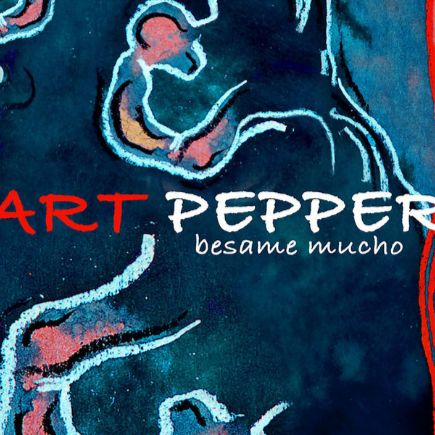Art Pepper: la voix nue du West Coast jazz
Saxophoniste et clarinettiste américain, Art Pepper (Arthur Edward Pepper Jr.) est reconnu comme l’un des plus grands saxophonistes alto de l’histoire du jazz. Figure emblématique du West Coast jazz aux côtés de Chet Baker, Gerry Mulligan ou Shelly Manne, il incarne un style d’une grande clarté formelle, traversé d’une intensité émotionnelle rarement égalée.
Issu d’un milieu instable, marqué par la pauvreté et les tensions familiales, il se tourne très jeune vers le saxophone et intègre dans les années 1940 les orchestres de Benny Carter et Stan Kenton. C’est avec ce dernier qu’il acquiert une notoriété nationale, porté par un jeu au phrasé limpide, au timbre chaud et expressif. Il enregistre ensuite avec Russ Freeman et Jack Montrose, affirmant sa place dans le paysage du jazz californien.
Mais sa carrière est rapidement rattrapée par l’addiction: l’héroïne devient un compagnon aussi constant que destructeur. Entre incarcérations et séjours en hôpital, il traverse les années 50 et 60 dans une alternance de fulgurances musicales et de dérives. Ses albums Art Pepper + Eleven, Meets the Rhythm Section ou Gettin’ Together — où il est accompagné par les sections rythmiques de Miles Davis — témoignent de sa virtuosité, de son lyrisme et d’un swing ardent, même dans la tourmente.
Dans les années 1970, après un long internement volontaire à Santa Monica, il entame une résurrection artistique. Living Legend (1975) marque son retour: un disque à nu, où sa sonorité fragile et intense devient le reflet direct de ses blessures.
Son chef-d’œuvre Today (1978) et la série The Complete Galaxy Recordings (1979-1982) capturent l’aboutissement d’une quête musicale et humaine. Chez Art Pepper, chaque note semble affleurer depuis la mémoire d’une douleur intime — et transforme cette douleur en art pur.
Art Pepper: la voz desnuda del jazz de la Costa Oeste
Saxofonista y clarinetista estadounidense, Art Pepper (Arthur Edward Pepper Jr.) es reconocido como uno de los más grandes saxofonistas de jazz de todos los tiempos. Emblema del jazz de la Costa Oeste junto a Chet Baker, Gerry Mulligan o Shelly Manne, su estilo combina una claridad formal exquisita con una intensidad emocional pocas veces igualada.
Creció en un entorno inestable, marcado por la pobreza y los conflictos familiares. Desde muy joven se acercó al saxofón y en los años 1940 entró en las orquestas de Benny Carter y Stan Kenton. Con este último adquirió renombre nacional gracias a su fraseo nítido y su tono cálido y expresivo. Más tarde grabó con Russ Freeman y Jack Montrose, consolidando su lugar en la escena jazz californiana.
Sin embargo, su carrera pronto quedó marcada por la adicción: la heroína se convirtió en una compañía destructiva. Entre cárceles y estancias en hospitales, atravesó las décadas de los 50 y 60 alternando momentos de brillantez musical y caídas personales. Álbumes como Art Pepper + Eleven, Meets the Rhythm Section o Gettin’ Together —en los que lo acompañan secciones rítmicas vinculadas a Miles Davis— reflejan su virtuosismo, su lirismo y un swing ardiente, incluso en la turbulencia.
En los años 70, tras un prolongado ingreso voluntario en una clínica de Santa Mónica, inició una resurrección artística. Living Legend (1975) marca su regreso: un disco desnudo, en el que su sonido frágil e intenso refleja directamente sus heridas.
Su obra maestra Today (1978) y la serie The Complete Galaxy Recordings (1979–1982) capturan la culminación de una búsqueda musical y humana. En cada nota de Art Pepper parece aflorar el recuerdo íntimo de un dolor — convertido en arte puro.
Art Pepper: la voce nuda del jazz West Coast
Sassofonista e clarinettista americano, Art Pepper (Arthur Edward Pepper Jr.) è considerato uno dei più grandi sassofonisti jazz di tutti i tempi. Figura iconica del jazz West Coast accanto a Chet Baker, Gerry Mulligan o Shelly Manne, il suo stile coniuga una chiarezza formale raffinata con un’intensità emotiva raramente eguagliata.
Cresce in un ambiente instabile, segnato da povertà e conflitti famigliari. Si avvicina al sax fin dall’adolescenza e negli anni ’40 entra nelle orchestre di Benny Carter e Stan Kenton. Con quest’ultimo acquisisce notorietà nazionale per il suo fraseggio limpido e il tono caldo ed espressivo. Successivamente registra con Russ Freeman e Jack Montrose, consolidandosi nel panorama jazz californiano.
Tuttavia, la sua carriera è presto segnata dalla dipendenza: l’eroina diventa una compagna distruttiva. Tra carceri e ricoveri, attraversa gli anni ’50 e ’60 alternando momenti di splendore musicale e cadute personali. Album come Art Pepper + Eleven, Meets the Rhythm Section e Gettin’ Together — con sezioni ritmiche legate a Miles Davis — testimoniano la sua virtuosità, il suo lirismo e uno swing ardente, persino nel caos.
Negli anni ’70, dopo un lungo ricovero volontario a Santa Monica, avvia una rinascita artistica. Living Legend (1975) segna il suo ritorno: un disco spoglio, in cui il suo timbro fragile e intenso riflette direttamente le sue ferite.
Il capolavoro Today (1978) e la serie The Complete Galaxy Recordings (1979–1982) catturano il compimento di un percorso musicale e umano. In ogni nota di Art Pepper affiora il ricordo intimo di un dolore — trasformato in arte pura.
Art Pepper: the naked voice of West Coast jazz
American saxophonist and clarinetist Art Pepper (Arthur Edward Pepper Jr.) is widely acknowledged as one of the greatest alto saxophonists in jazz history. A defining figure of West Coast jazz alongside Chet Baker, Gerry Mulligan, and Shelly Manne, he embodied a style of exceptional formal clarity infused with profound emotional intensity.
Raised in a turbulent environment marked by poverty and familial conflict, he took up the saxophone as a teenager and joined Benny Carter’s and Stan Kenton’s bands in the 1940s. It was with Kenton that he gained national acclaim, thanks to his lucid phrasing and warm, expressive tone. He later recorded with Russ Freeman and Jack Montrose, cementing his position in the Californian jazz scene.
But his career was soon overshadowed by addiction: heroin became a destructive constant. Shuttling between prison and hospital throughout the 1950s and ’60s, he alternated musical brilliance with personal decline. Albums like Art Pepper + Eleven, Meets the Rhythm Section, and Gettin’ Together—featuring rhythm sections associated with Miles Davis—highlight his virtuosity, lyrical sensitivity, and fiery swing, even amid chaos.
In the 1970s, following a lengthy voluntary stay at a Santa Monica treatment center, he began an artistic rebirth. Living Legend (1975) marked his return—a stripped-down record in which his fragile, intense tone reflected his inner scars.
His late masterpiece Today (1978) and the series The Complete Galaxy Recordings (1979–1982) captured the culmination of his musical and human journey. In Art Pepper’s playing, every note seems to emerge from a place of intimate suffering—transformed into pure art.

Autres articles – Otros artículos – Altri articoli
Styles de jazz – Estilos de jazz – Stili di jazz – Jazz Styles
The Man I Love–19.01.1957–Art PEPPER
Star Eyes–19.01.1957–Art PEPPER
You’d Be So Nice to Come Home To–19.01.1957–Art PEPPER
Rhythm-A-Ning–29.02.1960–Art PEPPER
Cherokee–30.07.1977–Art PEPPER
Blue Bossa–06.08-08.08.1977–Art PEPPER

